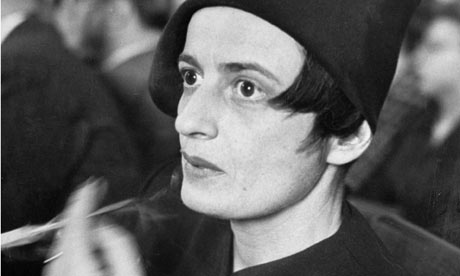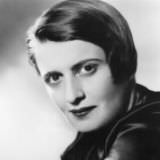Ayn Rand was born in St. Petersburg, Russia, on February 2, 1905. At age six she taught herself to read and two years later discovered her first fictional hero in a French magazine for children, thus capturing the heroic vision which sustained her throughout her life. At the age of nine, she decided to make fiction writing her career. Thoroughly opposed to the mysticism and collectivism of Russian culture, she thought of herself as a European writer, especially after encountering Victor Hugo, the writer she most admired.
During her high school years, she was eyewitness to both the Kerensky Revolution, which she supported, and in 1917, the Bolshevik Revolution, which she denounced from the outset. In order to escape the fighting, her family went to the Crimea, where she finished high school. The final Communist victory brought the confiscation of her father's pharmacy and periods of near-starvation. When introduced to American history in her last year of high school, she immediately took America as her model of what a nation of free men could be.

When her family returned from the Crimea, she entered the University of Petrograd to study philosophy and history. Graduating in 1924, she experienced the disintegration of free inquiry and the takeover of the university by communist thugs. Amidst the increasingly gray life, her greatest pleasures were Viennese operettas and Western films and plays. Long an admirer of cinema, she entered the State Institute for Cinema Arts in 1924 to study screenwriting. It was at this time that she was first published: a booklet on actress Pola Negri (1925) and a booklet titled "Hollywood: American Movie City" (1926), both reprinted in 1999 in Russian Writings on Hollywood.
In late 1925, she obtained permission to leave Soviet Russia for a visit to relatives in the United States. Although she told Soviet authorities that her visit would be short, she was determined never to return to Russia. She arrived in New York City in February 1926. She spent the next six months with her relatives in Chicago, obtained an extension to her visa, and then left for Hollywood to pursue a career as a screenwriter


Ayn Rand (born Alisa Zinov'yevna Rosenbaum) was a Russian-American novelist, philosopher, playwright, and screenwriter. She is known for her two best-selling novels and for developing a philosophical system she called Objectivism. Born and educated in Russia, Rand migrated to the United States in 1926. She worked as a screenwriter in Hollywood and had a play produced on Broadway in 1935–1936. She first achieved fame with her 1943 novel The Fountainhead. Over a decade later, she published her magnum opus, the philosophical novel Atlas Shrugged, in 1957.


During her high school years, she was eyewitness to both the Kerensky Revolution, which she supported, and in 1917, the Bolshevik Revolution, which she denounced from the outset. In order to escape the fighting, her family went to the Crimea, where she finished high school. The final Communist victory brought the confiscation of her father's pharmacy and periods of near-starvation. When introduced to American history in her last year of high school, she immediately took America as her model of what a nation of free men could be.

When her family returned from the Crimea, she entered the University of Petrograd to study philosophy and history. Graduating in 1924, she experienced the disintegration of free inquiry and the takeover of the university by communist thugs. Amidst the increasingly gray life, her greatest pleasures were Viennese operettas and Western films and plays. Long an admirer of cinema, she entered the State Institute for Cinema Arts in 1924 to study screenwriting. It was at this time that she was first published: a booklet on actress Pola Negri (1925) and a booklet titled "Hollywood: American Movie City" (1926), both reprinted in 1999 in Russian Writings on Hollywood.
In late 1925, she obtained permission to leave Soviet Russia for a visit to relatives in the United States. Although she told Soviet authorities that her visit would be short, she was determined never to return to Russia. She arrived in New York City in February 1926. She spent the next six months with her relatives in Chicago, obtained an extension to her visa, and then left for Hollywood to pursue a career as a screenwriter

Rand's Objectivism Philosophy
Once in the United States, Rand became a strong supporter of capitalism and a critic of communism. Her objectivism philosophy believed in individualism: that people should do what is in their own interests and live for themselves rather than others. Her philosophical view was premised on enlightened selfishness and rejected altruistic welfare in favour of self-reliance. Her belief was primarily declared in her second book, Anthem
Ayn Rand (born Alisa Zinov'yevna Rosenbaum) was a Russian-American novelist, philosopher, playwright, and screenwriter. She is known for her two best-selling novels and for developing a philosophical system she called Objectivism. Born and educated in Russia, Rand migrated to the United States in 1926. She worked as a screenwriter in Hollywood and had a play produced on Broadway in 1935–1936. She first achieved fame with her 1943 novel The Fountainhead. Over a decade later, she published her magnum opus, the philosophical novel Atlas Shrugged, in 1957.


No comments:
Post a Comment